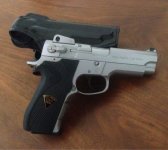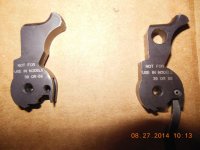A couple of days ago 18DAI here noted the difference in the 4006 hammer as compared to the 5906 hammer.
I, too, had noticed a difference in the early .40 hammers, specifically a large hole through the model 411 hammer.
As many who frequent this forum will attest after attempting to decipher the logic behind the numbering system, understand what passes for "numerical progression", or fathom the reason for the multiple frame profiles on a single model (the 5906): Smith & Wesson seemingly applies the same rules to manufacturing that most people bring to a knife fight.
In my sloth, I had assigned this very reasoning (or lack, thereof) to the difference in the hammers.
That is, until 18 brought it back up.
It was then I remembered reading about it in a magazine article some years ago and I resolved to find it. Luckily I didn't need to dig too deep.
From the January 1991 edition of American Rifleman (pg 22), an article entitled: "The .40 Smith & Wesson" (table of contents listing: "Smith & Wesson's New .40") by Charles E. Petty,
I quote:
"When I saw the first production Model 4006, I noticed that the hammer was blued. This was unusual and my first thought was that S&W had run out of plated hammers and had substituted a blued hammer as an expedient. A flash chrome plating process is used on stainless steel hammers because stainless lacks the hardness necessary for continuous impacts with the firing pin. Further examination, however, revealed a cut in the rear of the hammer to reduce the weight.
A call to S&W provided the answer. The lighter hammer serves a dual purpose. It was developed in S&W's new "Performance Center" to speed lock time on competition pistols. S&W reports that lock time is reduced by 28%, which is certainly a plus for the shooter, but it also serves a more practical function.
We tend to think that the hammer is cocked as the slide moves to the rear but, in fact, the hammer is knocked back rather violently by the initial recoil impulse before the slide moves more than a fraction of an inch. The hammer strikes the tang of the frame and often rebounds.
By this time, though, the slide has moved to the rear and the hammer can strike the under surface of the slide in the area of the disconnector cut. Battering can result after extensive shooting, and the lighter hammer serves to reduce or eliminate this concern." (emphasis added)
End of quote.
So there you have it. It seems the .40S&W cartridge increased slide velocity to a point which mandated the use of a lighter hammer. And the MIM hammer which followed apparently was not scalloped to save money or material but was a proven method of making our Smith & Wesson pistols run better and last longer.
John






